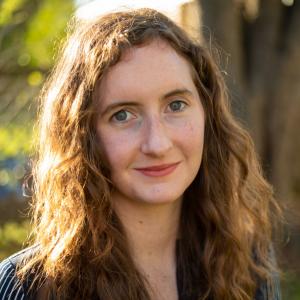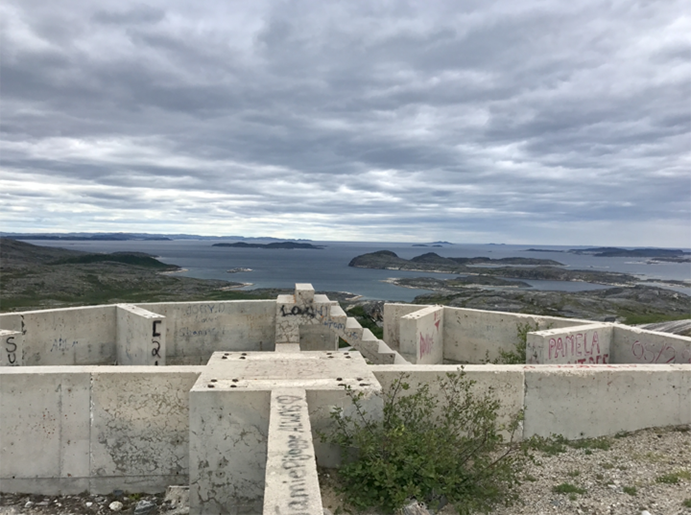Grant winner focuses on Inuit-military relations during the Cold War
Anthropology PhD student Emma Gilheany partners with an arctic indigenous community to help tell the region’s recent history
By Sarah Steimer
Few images of the Cold War include Americans stationed in the arctic, but a project from University of Chicago anthropology student Emma Gilheany looks to paint a picture of military and indigenous interactions during the period. The research focuses on the period from 1951 to 1968 in the circumpolar north of Canada, when the US military was present in Hopedale, Nunatsiavut. Gilheany, who’s entering her sixth year in the anthropology PhD program, will have her work partially funded through a $5,000 David R. and Mady W. Segal Fund for Social Sciences Research on Military Personnel grant.
Gilheany came to the topic after taking a course on the anthropology of indigeneity with Mareike Winchell, an assistant professor of anthropology and social sciences, along with reading “Decolonizing Methodologies” by Linda Tuhiwai Smith. Smith argues that researchers working with an indigenous group should engage in projects that have been specifically requested by the group, rather than coming into the space and pitching their own ideas or projects.
“My first year, I sent out about 100 emails to try to figure out if there were any archaeologists working on projects that indigenous nations were specifically requesting, prior to archaeologists coming into the community,” Gilheany says. Through her networking, she learned about Nunatsiavut, a self-governing Inuit region located in the northern region of Labrador, Canada.
Gilheany joined other archaeologists in Nunatsiavut before deciding to collaborate directly with those living in the region.
“I wanted to think critically about how to start a community-based archaeology project,” she says.
Since 2017, Gilheany has worked with the Inuit heritage group in Hopedale — the legislative capital of Nunatsiavut — along with other community members and the archival manager of the Hopedale Museum to design an archaeology project for the community.
In her first year in Hopedale, Gilheany says she would introduce herself as an American, which frequently prompted community members to describe radar surveillance stations manned by the U.S. Air Force. Hopedale is part of the Pinetree Line series of stations, built in cooperation between Canada and the U.S. The military personnel stationed there were tasked with detecting incoming USSR missiles to warn civilians in the lower 48 states to duck and cover, and to ensure the threat of mutually assured destruction. Such Arctic stations were often within Inuit communities because of existing infrastructures such as airstrips, harbors, or trade stops.
Gilheany’s project focuses on the memories of both USAF servicemen and the indigenous communities who experienced these occupations. The result will widen the scope of Cold War actors to include Inuit persons and shed light on Inuit-U.S. military relations. Hopedale and its 540-person Inuit community will serve as a case study on the topic, which covers the socialization to and interpersonal relationships within the culture of USAF Arctic radar bases, along with Inuit attitudes toward and memories of the military.
In addition to her interviews with the men who manned the stations, Gilheany has also mined information from a website on the Pinetree Line. Because she couldn’t visit Hopedale during the pandemic, Gilheany focused her time on getting her certificate in Computational Social Science through the University of Chicago, using her new skills to pore through the Pinetree website. The site was used as a social forum between 1997 and 2005 for those who were stationed in these locations looking to share their experiences — which they weren’t allowed to speak on for decades because of the stations’ secrecy during the Cold War.
“The people I’ve been able to speak to have been really excited to share this time in their life,” Gilheany says. “Multiple people have said to me, ‘Look, I'm 80 years old. If you asked me what I did in 1986, I would say I was raising my children or something. But if you asked me what I was doing in 1959 when I was stationed in Hopedale, I can tell you exactly what I did each day. I have such vivid memories of being stationed up there.’”
One such memory that can help shed a new light on the region’s recent history: The military personnel witnessed the forced relocation of Inuit people when the Canadian government closed the community of Hebron in Nunatsiavut in 1959.
“The American servicemen were witnessing this and taking photos of it, then they put it on this website as one of their memories of being there,” Gilheany says. “It's an interesting sort of feedback loop of who's witnessing different forms of imperialism or settler colonialism.”
That loop includes Inuit voices, which is one of the goals that the Hopedale community outlined to Gilheany, which can help create a fuller record of the region’s military occupation.
Gilheany is choosing not to return to Hopedale until the pandemic abates, so the grant will help her focus on long-distance interviews with subjects. And while her focus is currently on the military stations, she plans to make working with and helping to tell the stories of the Hopedale community her lifelong project.



